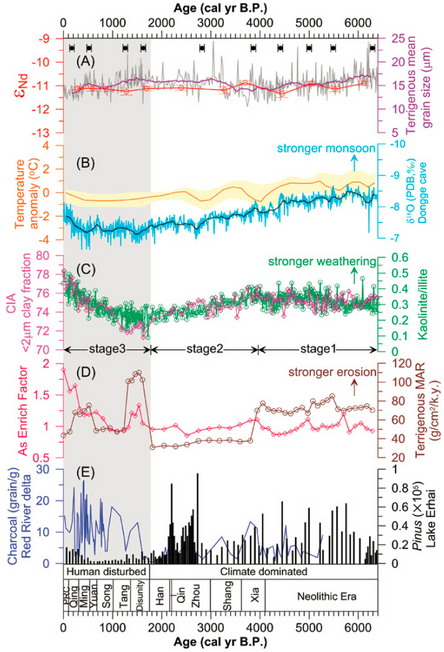|
|
| Human impact overwhelms long-term climate control of weathering and erosion in southwest China |
 |
Text Size: A A A |
|
- Shiming Wan1, Key Laboratory of Marine Geology and Environment, Institute of Oceanology, Chinese Academy of Sciences, Qingdao 266071, China
- Samuel Toucanne2, Peter D. Clift3, Debo Zhao1,Germain Bayon2,4, Zhaojie Yu5, Guanqiang Cai6, Xuebo Yin1,Sidonie Révillon7, Dawei Wang1, Anchun Li1 and Tiegang Li1
During the Holocene there has been a gradual increase in the influence of humans on Earth systems. High-resolution sedimentary records can help us to assess how erosion and weathering have evolved in response to recent climatic and anthropogenic disturbances. Here we present data from a high-resolution (∼75 cm/k.y.) sedimentary archive from the South China Sea. Provenance data indicate that the sediment was derived from the Red River, and can be used to reconstruct the erosion and/or weathering history in this river basin. Accelerator mass spectrometry 14C dating provides direct age control and reveals coherent variations in clay mineralogy, geochemistry, and terrigenous flux, indicative of strong chemical weathering and physical erosion during the mid-Holocene warm period (6400–4000 cal [calibrated] yr B.P.), followed by weakening from ca. 4000–1800 cal yr B.P., and renewed intensification since 1800 cal yr B.P.. Comparison with climatic records from China indicates that precipitation and temperature controlled both physical erosion and chemical weathering intensity before 1800 cal yr B.P.. However, weathering proxies in the offshore sediment indicate recent increased soil erosion. We suggest that enhanced human activity (deforestation, cultivation, and mining) since the end of the Chinese Han Dynasty (220 CE) has overwhelmed the natural climatic controls on erosion in the Red River.  - Received 27 December 2014; Revision received 15 February 2015; Accepted 25 February 2015.
- © Geological Society of America
- http://geology.gsapubs.org/content/early/2015/03/27/G36570.1.abstract
|
|

